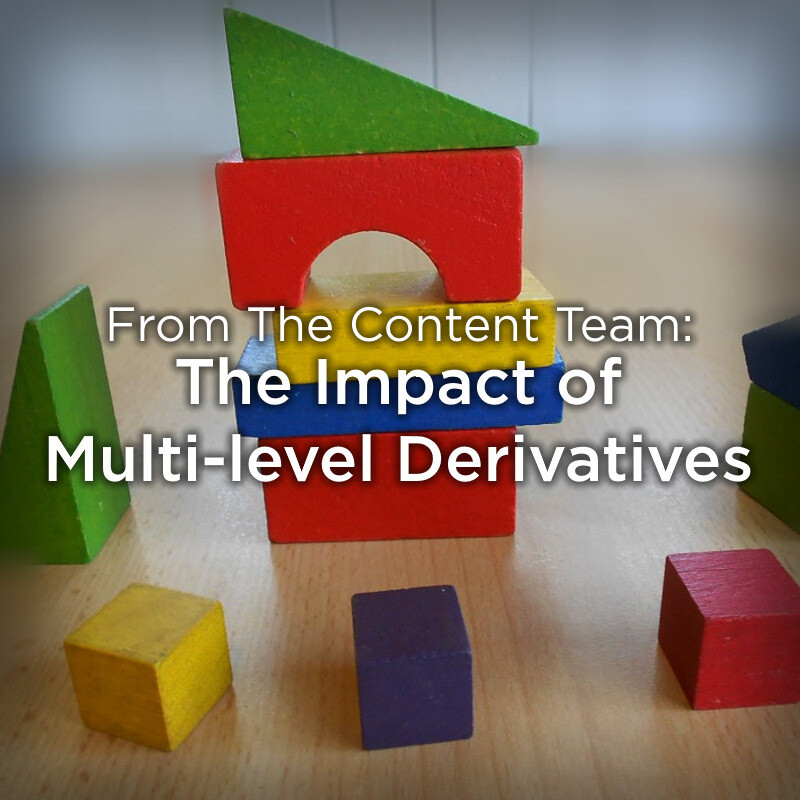In this series, one of FundApps’ dedicated compliance experts covers a regulatory issue. This week, we have Ben Richards, Compliance Analyst at FundApps, writing about the impact of multi-level derivatives on shareholding disclosure.
In many jurisdictions, financial derivatives must be included in determining how much exposure a holder has in an issuer - somewhat surprising when considering the term “Shareholding Disclosure”. These derivatives don’t always have to give the holder the actual right to own the underlying shares to be included in the calculation - simply financial exposure to an issuer may be reportable. Conceptually, a holder could have over 100% exposure to an issuer, through a mix of direct holdings of a security and cash-settled financial derivatives.
Are you confused by this? So are compliance teams around the world.
Given the breadth and complexity of financial derivatives, determining this exposure can be a huge challenge. Understanding the multi-level construction of the assets in question and knowing when to include and exclude them in the holding calculation greatly complicates the disclosure process. A multi-level construction may only yield a low exposure to the underlying security, but it could be the difference between a 4.98% holding and a 5.01% that breaches a reportable threshold.
TD2 Implementation of Multi-level Derivatives
Let’s take the implementation of the Amended Transparency Directive (TD2) as an example. Under the TD2, two groups of financial instruments that were subject to disclosure were set out as:
"financial instruments that are disclosable as either: (i) entitlements to acquire; or (ii) instruments with similar economic effect to holding shares or an entitlement to acquire shares."
What does that mean? Simply, an entitlement to acquire the underlying security is subject to disclosure. Cash-settled derivatives (e.g. CFDs, amongst others) are also subject to disclosure, as they can be deemed to have a “similar economic effect” as ownership of the shares themselves. To complicate matters, the TD2 also set out that only cash-settled instruments are to be delta adjusted. It also outlines the inclusion of securities held via indices, baskets or ETFs with no specification on where in the construction such an instrument could lie. In theory, a holder could have a responsibility to disclose stemming from the following:
Future → Index → ADR → Equity
More than enough to get your head scratching and very easy to misinterpret. The above is, however, subject to a condition. The condition (also outlined in the TD2) states securities held through indices or ETFs are only to be included:
"where the underlying security represents 20% or more of the value of the basket or makes up 1% or more of the total voting rights of the issuer."
Multi-level derivatives can quickly become the undoing of even the most capable compliance team, due to their extremely complex and intricate nature. Intricacies in the calculations for the above must also be known. For instance, if a fund were to hold the construction above and see a change in the index price, the holder’s exposure to an underlying security would be altered. If such a marginal change results in a disclosure threshold being tripped from one day to the next, a disclosure would be required.
In a separate regulatory regime, the UK Takeover Panel for example, such a change is not subject to a subsequent dealings disclosure (assuming 1% or more of a class of security is owned). This highlights that one’s assumptions regarding changes in exposure cannot be extended across regimes within a given jurisdiction, let alone across jurisdictions.
Again, confused?
Without rewriting the textbook on shareholding disclosure, it’s clear to imagine the benefits of a service that can automatically calculate a fund’s exposure (and thus its responsibility to disclose) from multi-level derivatives, taking into account the nuances from each regulatory regime. Even if one has a solid understanding of their responsibility to disclose, a change in law can quickly make a complicated matter even more so.
